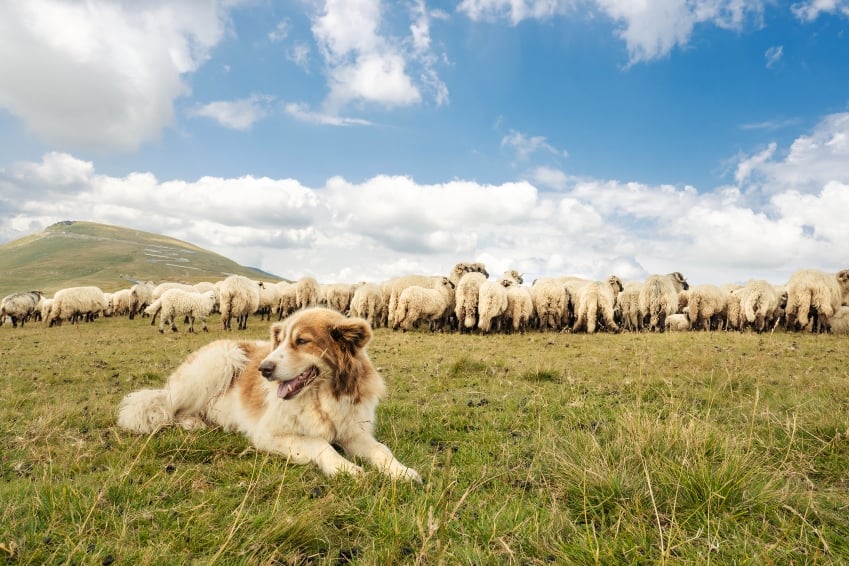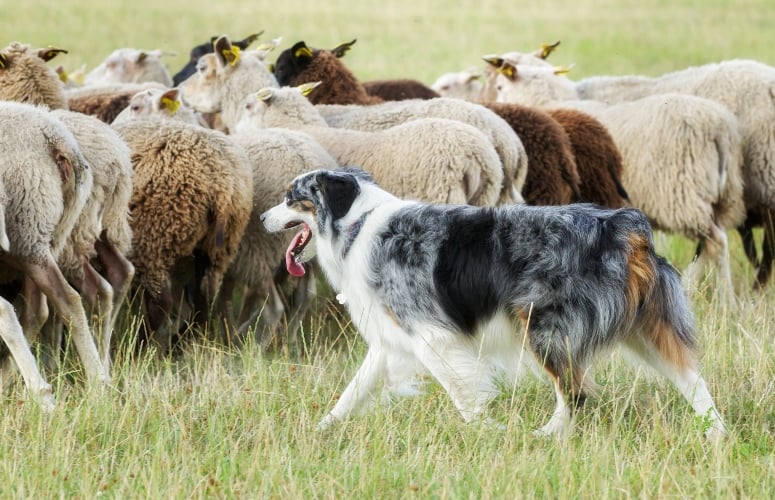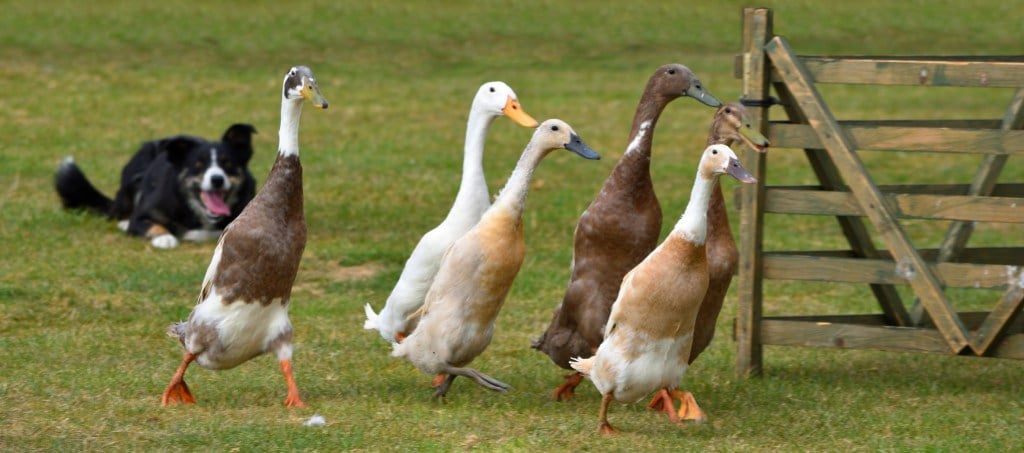Key Takeaways
- Dogs have been utilized for centuries to help herd animals. But even if you live in a city without livestock around, you can help your herding dog to engage their natural instincts.
- The dog breeds most likely to have a herding instinct are Border collies, Australian cattle dogs, Australian shepherds, sheepdogs, Corgis, and Belgian Malinois.
- Herding is a specialized skill, and you will probably need help from a professional. Be patient, as it can take some time for your dog to learn and there are many steps along the way.
Table of Contents
Reviewed by Flora Steffan, professional dog trainer
Does your dog like to chase the lawn mower or cars or round up running children, chickens, or dogs at your local dog park? If so, you may have a dog with herding ancestry from the “Herding Group” of breeds.
Dogs have been utilized for centuries to help herd animals, and many ranchers still rely on them worldwide. But even if you live in a city without livestock around, you can help your herding dog to engage their natural instincts.
Herding is a modified predatory behavior, and if your dog tends to move in a circular motion around you or your other animals, they may have strong herding abilities, says Eukanuba. These smart and active dogs need a lot of stimulation, and teaching them to herd livestock can be a perfect way to exercise their mind and body, and strengthen the bond between you and your dog.

What is a herding dog?
If teaching a dog to herd is a priority for you, then you should adopt a dog that was bred for herding. Border collies, Australian cattle dogs, Australian shepherds, sheepdogs, Corgis, and Belgian Malinois are some of the more common herding breeds, and excel in herding due to their intelligence, agility, and stamina, according to the American Kennel Club. Besides breeders, there are dog rescues that specialize in saving herding breeds and many people are looking to rehome herding dogs on Petfinder.
“All herding breeds share an instinctual ability to control the movement of other animals. These breeds were developed to gather, herd and protect livestock,” the AKC says. “The herding instinct in these breeds is so strong that herding breeds have been known to gently herd their owners, especially the children of the family. In general, these intelligent dogs make excellent companions and respond beautifully to training exercises.”
While breed is a big factor, many mixed-breed dogs with some herding DNA may also be capable of herding, and even non-herding breeds can be taught, but they probably won’t be as proficient as a herding breed, said Flora Steffan, a dog trainer and founder of Herd U Needed a Home herding dog rescue in Central Oregon.
Not all dogs are suited to herding, and the training process requires patience, consistency, and understanding of animal behavior. Besides breed, many factors play into how quickly your dog will progress – age, temperament, socialization, handler’s ability, conformation, amount of time spent practicing, and how well they listen to the instructor. Some dogs may pick it up in minutes and others will take weeks. It can’t be rushed.
In this blog post, we’ll guide you through the basics of how to teach a dog to herd.
Basics of herding training
1. Teach basic obedience first
Before starting herding-specific training, your dog should already know basic obedience commands like sit, stay, come, and down. They should also have excellent recall and know “wait,” Steffan said. They will need these skills so they can be managed in the field. Any certified dog trainer can help teach these skills.
2. Test your dog for aptitude
Many breed clubs and herding organizations offer instinct tests to evaluate a dog’s aptitude for herding. This can be a helpful step in determining whether your dog is ready and willing to learn herding. Your dog will be judged on qualities such as interest, balance, power and temperament. If your dog doesn’t do well on the test, herding is not for them and you should consider other activities to keep them stimulated and content. Agility training uses many of the same skills as herding, and has the same advantages, but doesn’t expose the dogs to livestock.
3. Start young, but not too young
It’s easier to train a dog for herding when they’re young, although older dogs can also learn. That doesn’t mean your eight-week-old puppy can be thrown in with a bunch of sheep. Herding dogs are moving constantly, turning quickly and at times getting in harm’s way. If your dog incurs an injury at a young age, before they are fully developed, it may cause a permanent disability that can affect their working ability, the AKC says. Before attempting herding, your pup must become toned and physically fit and have the mental maturity that comes with age. Steffan recommends starting training puppies on basic obedience as early as possible but waiting until they are a year old to try herding. Puppies are best able to learn and retain information before they are seven months old, she said.
During this time, pet parents may also attend a herding clinic without their puppy to see how the training works, and whether they think it is right for their dog.
4. Find a herding instructor
Herding is a specialized skill, and the training should ideally be overseen by an experienced instructor. Look for someone with a track record of training herding dogs who uses positive reinforcement techniques. Choose a program where you are actively involved in the training rather than one where they train your dog for you, as training is more for the human anyway. That way, you will have the skills to continue helping your dog improve and experience the bond that forms between dog and trainer.
5. Learn the basic commands
In herding, dogs need to learn new commands to move livestock in specific directions. Some of the common commands are:
- “Come-bye” (move clockwise)
- “Away” or “go-bye” (move counterclockwise)
- “Walk up” (move forward)
- “Lie down” (stop moving)
- “Out” (disengage from the stock and move directly away until told to stop)
- “That’ll do” (the dog should mentally turn loose of the stock and leave)
- “There” (used to orient the dog)
6. Practice without livestock
It will probably take some time before you and your dog are ready to herd actual livestock, but there are exercises you can practice at home that will speed things up, create a partnership with your dog, and build crucial skills that are transferable to herding, said Dancing Hearts Dog Academy. It’s not just your dog that has learning to do. You, as the handler, will need to learn how to move, stand, posture and focus to help your dog herd. Watch videos of people working with herding dogs and you will be able to visualize what kind of footwork and gesturing will be needed. You can practice this at home, with or without your dog. Teaching your dog agility and scent work will also prepare them well for livestock as the skills are similar, Steffan said.
Start practicing some of the language and movement you will be using to direct your dog while you don’t have the distractions of sheep, says Kathy Kawalec of Dancing Hearts. Teach your dog to move in, hold/pause, and move out. These skills will help your dog learn to be attentive to personal space, with both you and the animals being herded. Start with your dog close to you, then move further apart.
One way to practice this is to utilize a gateway or doorway, Steffan said. Teach your dog to wait until you release them to walk through the gateway. This teaches them to be attentive and responsive to your communication. “Humans should always go through the door first, whether in a house or the car or elsewhere. You then invite your dog to join you. This is one of the first things I teach my dogs,” Steffan said.
7. Find a farm where you can practice
Once your dog has learned some herding basics, you might see if you can find a farm where they can practice on livestock. Many enterprising ranchers have developed businesses where city dogs can herd sheep, cows, and ducks in a rural environment. One such business is Fido’s Farm, located near Olympia, Wash. They sell a $25 day pass for dogs to herd sheep and a $30 pass to herd cattle for 30 minutes. They offer lessons and evaluations for both sheep and cow herding. All dogs that visit herding farms will need to be have basic obedience skills, and be healthy, non-aggressive and current on their immunizations.
8. Use appropriate livestock and start small
Once your dog is ready, start training with livestock that are used to dogs and won’t panic or become aggressive. Ducks and sheep are often the best option for beginners. Start with a small animal, like a duck, lamb or calf, and work toward larger animals and herds. Begin training in a small, enclosed area to keep the livestock and your dog contained. As your dog becomes more skilled, you can move to larger areas and introduce more complex commands.
9. Join a local herding club
You might be able to meet other herding dog pet parents or trainers and learn some training tips in one of the many herding dog clubs. If your dog turns out to be the Michael Jordan of herders, you might choose to participate in herding trials, where dogs are scored on their herding abilities according to test level, course type, and livestock type.
Conclusion
Teaching a dog to herd can be a profoundly rewarding experience that deepens the bond between you and your dog while tapping into their innate abilities. With the right breed, training, and patience, your dog can become an adept herder, whether for competitive sports or practical livestock management.










